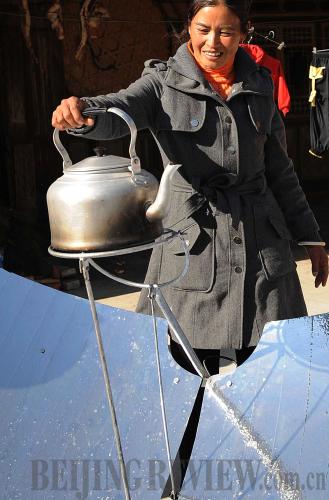|
 |
|
GREEN AWARENESS: solar cooking (XINHUA) |
Carbon trading
Using effective financial incentives to improve energy efficiency is necessary in any country's green transformation. China is no exception. Green finance, or G-finance, is today a buzzword in China. It refers to credit aimed to support the development of low-carbon green sectors, as well as green-oriented reform in conventional industries.
The National Bureau of Statistics' data prove that a series of carbon reducing measures implemented by the government in the last few years have been effective. In September 2009, loans granted by major Chinese commercial banks to the high energy-consuming industries such steel and electrolytic aluminum increased by 13 and 19 percent respectively, much lower than the average increase rate of 31 percent in the same period of the previous year.
Take Bank of China (BOC) for example. By the end of the first quarter of 2010, the balance of BOC's energy-saving and emission-reducing credit extension exceeded 180 billion yuan ($26.8 billion), with an annual double-digit growth rate. The percentage of such loans in the bank's total credit has been increasing.
By 2020, China's new energy industry could require more than 2 trillion yuan ($298 billion) in funding. Also, more than 600 billion yuan ($89.6 billion) is required annually for emission reduction, recycling natural resources and environmental protection. China's potential carbon market is estimated to exceed 300 billion yuan ($44.8 billion), said financial expert Gao Cailin at a high-level international financial meeting held in northeast China's Jilin Province this September. Gao said that soaring demand for investment would provide huge potential for the development of green finance.
To develop G-finance, the expert suggested that the government should establish not only a G-finance supervision mechanism to map out related policies, but also an open financial market to encourage capital to flow to eco-friendly sectors.
Carbon trading is another component in the development of China's low-carbon economy.
First recognized in the Kyoto Protocol in 1997, carbon trading is a form now commonly practiced by many countries in order to meet their obligations to reduce carbon emissions under the Kyoto Protocol and help tackle global climate change.
As world carbon trading grows, China has made a breakthrough in the sector. In a bid to create a national emissions trading platform, China set up carbon-trading exchanges in Beijing, Shanghai and Tianjin in 2008, where emission rights can be traded.
The Clean Development Mechanism (CDM) is a central pillar within China's path to carbon trading development, said Liu Deshun, Professor at the Climate Change Institute of Tsinghua University.
China has been greatly involved in the CDM projects, with more than 2,300 projects approved by NDRC by the end of last year. "The establishment of emission exchanges in China will further facilitate CDM projects to succeed, and help introduce overseas financial and technical support for Chinese businesses," said Liu.
The professor also suggested that the government should encourage commercial banks create new financial services, like a special carbon fund that offers loans for CDM projects.
|